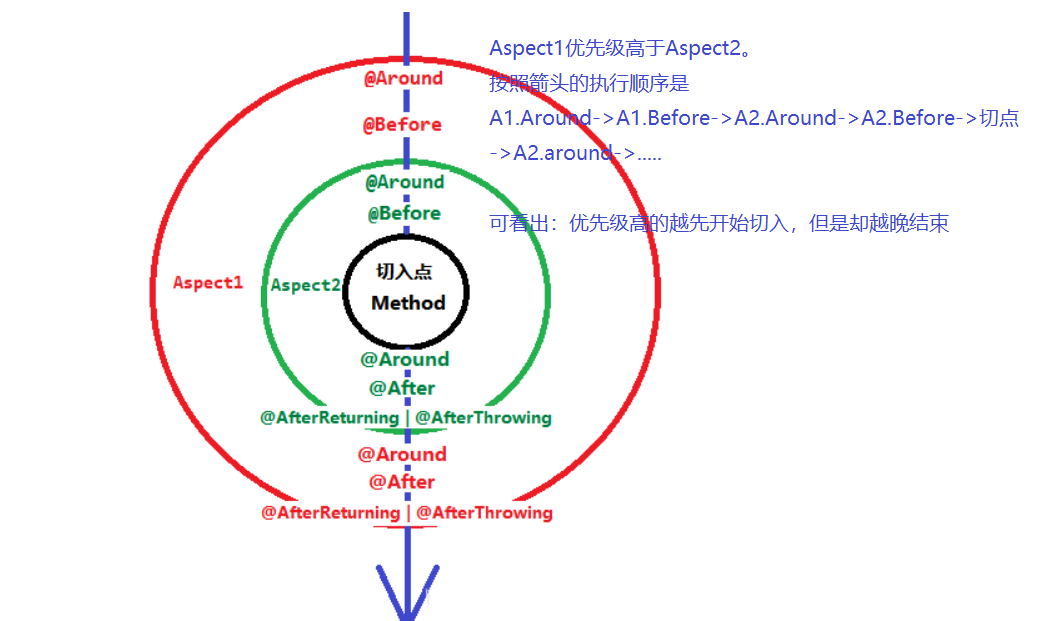
Spring AOP的使用
一,AOP基础概念
- 连接点(Join Point):可以认为ioc容器的所有类(不包括切面类)的所有方法执行(运行时的方法)都是JoinPoint,他们都能被增强
- 切点(Poincut):定义了切入哪些连接点,即增强哪些方法(通过表达式或注解声明这些方法)
- 通知(Advice):定义了如何切入(before,after,around…)
- 切面(Aspect):由@Aspect定义的类即为切面类,切面类声明了如何用切点和通知来增强连接点
- 织入(Weaving):AOP的创建代理对象的方式(编译期织入、类加载期织入、运行期织入)
二,AOP的使用
1. aop环境配置
pom.xml
1
2
3
4
5<!--aop 切面-->
<dependency>
<groupId>org.springframework.boot</groupId>
<artifactId>spring-boot-starter-aop</artifactId>
</dependency>Application启动类开启注解
1
@EnableAspectJAutoProxy(exposeProxy = true)//启用AOP自动代理,允许暴露代理类
2. 切面的声明
基本步骤就是声明为切面类,定义切点表达式,编写advice通知方法
切点表达式(指明增强的方法)
execution表达式
- execution(* com.wqhuanm...(..)) 任意返回类型,com.wqhuanm的包及其子包,任意类 ,任意方法 ,(..)任意参数
- execution(public int com.wqhuanm.MyserviceImpl.*(String name, ..)) public且返回为int,指定类的任意第一个参数为string的方法
@annotation注解
1
2
3
4
5
6
7
8
9@Pointcut("@annotation(com.learn.annotation.SystemLog)")//增强使用了这个注解的方法
public void pt() {
}
@Target({ElementType.METHOD})
@Retention(RetentionPolicy.RUNTIME)
public @interface SystemLog {
String BusinessName();// 接口调用该注解时,声明其相应功能,如@SystemLog(BusinessName = "更新个人信息")
}
连接点JoinPoint
- JoinPoint:用于获取目标对象/代理对象/方法签名/参数
- ProceedingJoinPoint:JoinPoint的子接口,提供proceed():执行目标方法
advice通知写法
1
2
3
4
5
6
7
8
9
10
11
12
13
14
15
16
17
18
19
20
21
22
23
24
25
26@Aspect//声明为切面类
@Component
public class LogAspect {
@Pointcut("execution(* com.wqhuanm.learn..*.*(..))")
public void logPt(){}//函数名用于声明该切点的名字
@Before("logPt()")
public void beforePrint(JoinPoint jp){
System.out.println("before print: "+jp.getSignature().getName());
}
@Around("logPt()")
public void aroudPrint(ProceedingJoinPoint jp){
Object ans=null;
System.out.println("Before");
try {
ans= jp.proceed();
System.out.println("AfterReturning");
} catch (Throwable e) {
System.out.println(e.getMessage());
System.out.println("AfterThrowing");
}finally {
System.out.println("After");
}
}
}
三,多个AOP的执行顺序
- AOP的优先级由他们的order值决定,order值越低,优先级越高。spring aop(包括事务)的优先级默认都是Integer.MAX_VALUE(即优先级最低)
- 如果切面间优先级相同,则由他们注册到Spring的顺序决定谁优先级高(越先注册越高),事务之类的基础设施切面的注册往往早于自定义切面的注册时机
- 多个切面可以看成是以方法执行为圆心,优先级越高的切面在外环,越低的在内环。而切面的执行可看成一个箭头穿过圆环得到的顺序(优先级越高,越先开始,但是越晚结束)
- 优先级的定义
- 自定义切面可以在切面类上注解@Order(value)来设定order值(直接作用于方法上无效)
- Spring的事务优先级可在启动类上设置@EnableTransactionManagement(order = value)来设置order值
- 事务与自定义切面同时使用可能存在的问题
- 在均为设定优先级时,事务切面比自定义切面早注册,在外环
- 如果事务内容抛出异常,会先被自定义切面捕获,如果切面处理异常后没有把异常抛出,则事务切面接受不到异常,不会执行回滚
- 解决思路
- 要么提高自定义切面优先级,让事务处理后再到切面catch异常
- 要么自定义切面要抛出异常
附录:使用AspectJ
只需引入下面依赖
1 | |

